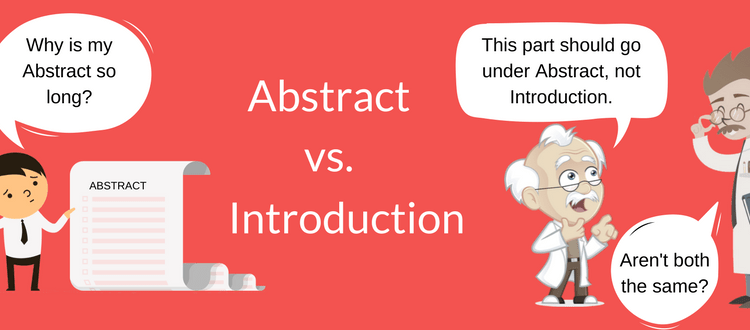Abstract Vs. Introduction — Do you know the difference?

Ross wants to publish his research. Feeling positive about his research outcomes, he begins to draft his manuscript. After completing the abstract, he proceeds to write the introduction. That’s when he pauses in confusion. Do the abstract and introduction mean the same? How is the content for both the sections different?
This is a dilemma faced by several young researchers while drafting their first manuscript. An abstract is similar to a summary except that it is more concise and direct. Whereas, the introduction section of your paper is more detailed. It states why you conducted your study, what you wanted to accomplish, and what is your hypothesis.
This blog will allow us to learn more about the difference between the abstract and the introduction.
What Is an Abstract for a Research Paper?
An abstract provides the reader with a clear description of your research study and its results without the reader having to read the entire paper. The details of a study, such as precise methods and measurements, are not necessarily mentioned in the abstract. The abstract is an important tool for researchers who must sift through hundreds of papers from their field of study.
The abstract holds more significance in articles without open access. Reading the abstract would give an idea of the articles, which would otherwise require monetary payment for access. In most cases, reviewers will read the abstract to decide whether to continue to review the paper, which is important for you.
Your abstract should begin with a background or objective to clearly state why the research was done, its importance to the field of study, and any previous roadblocks encountered. It should include a very concise version of your methods, results, and conclusions but no references. It must be brief while still providing enough information so that the reader need not read the full article. Most journals ask that the abstract be no more than 200–250 words long.
Format of an Abstract
There are two general formats — structured and unstructured. A structured abstract helps the reader find pertinent information very quickly. It is divided into sections clearly defined by headings as follows:
- Background: Latest information on the topic; key phrases that pique interest (e.g., “…the role of this enzyme has never been clearly understood”).
- Objective: The research goals; what the study examined and why.
- Methods: Brief description of the study (e.g., retrospective study).
- Results: Findings and observations.
- Conclusions: Were these results expected? Whether more research is needed or not?
Authors get tempted to write too much in an abstract but it is helpful to remember that there is usually a maximum word count. The main point is to relay the important aspects of the study without sharing too many details so that the readers do not have to go through the entire manuscript text for finding more information.
The unstructured abstract is often used in fields of study that do not fall under the category of science. This type of abstracts does not have different sections. It summarizes the manuscript’s objectives, methods, etc., in one paragraph.
Related: Create an impressive manuscript with a compelling abstract. Check out these resources and improve your abstract writing process!
Lastly, you must check the author guidelines of the target journal. It will describe the format required and the maximum word count of your abstract.
What Is an Introduction?
Your introduction is the first section of your research paper. It is not a repetition of the abstract. It does not provide data about methods, results, or conclusions. However, it provides more in-depth information on the background of the subject matter. It also explains your hypothesis, what you attempted to discover, or issues that you wanted to resolve. The introduction will also explain if and why your study is new in the subject field and why it is important.
It is often a good idea to wait until the rest of the paper is completed before drafting your introduction. This will help you to stay focused on the manuscript’s important points. The introduction, unlike the abstract, should contain citations to references. The information will help guide your readers through the rest of your document. The key tips for writing an effective introduction:
- Beginning: The importance of the study.
- Tone/Tense: Formal, impersonal; present tense.
- Content: Brief description of manuscript but without results and conclusions.
- Length: Generally up to four paragraphs. May vary slightly with journal guidelines.

Once you are sure that possible doubts on the difference between the abstract and introduction are clear, review and submit your manuscript.
What struggles have you had in writing an abstract or introduction? Were you able to resolve them? Please share your thoughts with us in the comments section below.










Insightful and educating Indeed. Thank You
Quite a helpful and precise for scholars and students alike. Keep it up…
thanks! very helpful.
thanks. helped
Greeting from Enago Academy! Thank you for your positive comment. We are glad to know that you found our resources useful. Your feedback is very valuable to us. Happy reading!
Really helpful as I prepare to write the introduction to my dissertation.
Thank you Enago Academy
This gave me more detail finding the pieces of a research article being used for a critique paper in nursing school! thank you!
The guidelines have really assisted me with my assignment on writing argument essay on social media. The difference between the abstract and introduction is quite clear now for me to start my essay…thank you so much…
Quite helpful! I’m writing a paper on eyewitness testimony for one of my undergraduate courses at the University of Northern Colorado, and found this to be extremely helpful in clarifications
This was hugely helpful. Keep up the great work!
This was quite helpful. Keep it up!
Very comprehensive and simple. thanks
As a student, this website has helped me greatly to understand how to formally report my research
Thanks a lot.I can now handle my doubts after reading through.
thanks alot! this website has given me huge clarification on writing a good Introduction and Abttract i really appreciate what you share!. hope to see more to come1 God bless you.
Thank you, this was very helpful for writing my research paper!
That was helpful. geed job.
Thank you very much. This article really helped with my assignment.
Woohoo! Amazing. I couldnt stop listening to the audio; so enlightening.
Thank you for such a clear breakdown!
I am grateful for the assistance rendered me. I was mystified over the difference between an abstract and introduction during thesis writing. Now I have understood the concept theoretically, I will put that in practice. So thanks a lots it is great help to me.